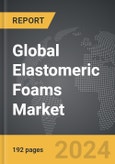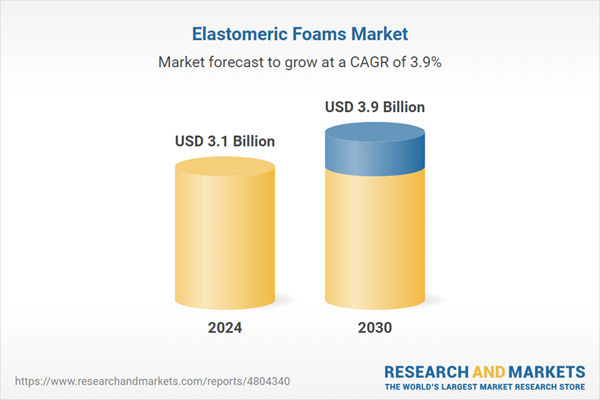The global market for Elastomeric Foams was valued at US$3.1 Billion in 2024 and is projected to reach US$3.9 Billion by 2030, growing at a CAGR of 3.9% from 2024 to 2030. This comprehensive report provides an in-depth analysis of market trends, drivers, and forecasts, helping you make informed business decisions. The report includes the most recent global tariff developments and how they impact the Elastomeric Foams market.
Segments: Type (Synthetic Rubber, Natural Rubber / Latex); End-Use (HVAC, Automotive, Electrical & Electronics, Other End-Uses).
Geographic Regions/Countries: World; United States; Canada; Japan; China; Europe (France; Germany; Italy; United Kingdom; Spain; Russia; and Rest of Europe); Asia-Pacific (Australia; India; South Korea; and Rest of Asia-Pacific); Latin America (Argentina; Brazil; Mexico; and Rest of Latin America); Middle East (Iran; Israel; Saudi Arabia; United Arab Emirates; and Rest of Middle East); and Africa.
The analysts continuously track trade developments worldwide, drawing insights from leading global economists and over 200 industry and policy institutions, including think tanks, trade organizations, and national economic advisory bodies. This intelligence is integrated into forecasting models to provide timely, data-driven analysis of emerging risks and opportunities.
Global Elastomeric Foams Market - Key Trends and Drivers Summarized
What Are Elastomeric Foams?
Elastomeric foams are flexible insulation materials known for their rubber-like properties, primarily used in heating, ventilation, and air conditioning (HVAC) systems to prevent energy loss and protect against moisture. These foams are composed of either synthetic rubber or natural latex, making them highly resistant to weathering, ozone, UV radiation, and a variety of chemicals. Their closed-cell structure is crucial for providing excellent thermal insulation and moisture vapor resistance, which ensures systems operate efficiently and are protected from the degradation caused by condensation. The versatility of elastomeric foams allows for application in a wide range of temperatures, making them suitable for both indoor and outdoor use in residential, commercial, and industrial settings.How Do Elastomeric Foams Contribute to Energy Efficiency?
Elastomeric foams play a pivotal role in enhancing energy efficiency within buildings and mechanical systems. By forming a tight, insulative barrier around pipes and ductwork, these foams minimize thermal transfer, helping maintain the desired temperatures within HVAC systems with less energy expenditure. This thermal regulation capability reduces the load on heating and cooling systems, leading to significant energy savings over time. Furthermore, the moisture resistance of elastomeric foams prevents the formation of condensation, which can lead to mold growth and metal corrosion, thereby extending the longevity of HVAC components and improving air quality. This makes elastomeric foams an integral component in green building designs aiming for sustainability and operational efficiency.What Trends Are Impacting the Elastomeric Foam Market?
The elastomeric foam market is influenced by several trends that drive its innovation and adoption. The rising demand for more sustainable and energy-efficient building solutions has led to significant advancements in foam technologies, including the development of low-VOC, non-toxic options that meet stricter environmental regulations. The growing prevalence of green certifications, like LEED and BREEAM, encourages the use of materials that contribute to a healthier environment and energy conservation, which in turn boosts the demand for high-performance elastomeric foams. Moreover, as global urbanization continues, the need for effective insulation in densely packed urban environments escalates, further propelling the market forward.What Drives the Demand for Elastomeric Foams?
The growth in the elastomeric foam market is driven by several factors. There is a mounting emphasis on reducing energy consumption and minimizing carbon footprints in building management, making effective insulation more crucial than ever. Elastomeric foams address these needs with their superior insulation properties and durability. Additionally, technological advancements have led to enhanced properties such as fire resistance and eco-friendliness, broadening their applications across various industries. The construction sector's expansion worldwide, especially in emerging economies experiencing rapid industrialization and urbanization, also significantly contributes to the demand. Lastly, the shift towards maintaining healthier indoor air quality has emphasized the importance of using insulation materials like elastomeric foams that do not contribute to microbial growth or emit harmful substances, thus supporting the market's expansion.Report Scope
The report analyzes the Elastomeric Foams market, presented in terms of units. The analysis covers the key segments and geographic regions outlined below.Segments: Type (Synthetic Rubber, Natural Rubber / Latex); End-Use (HVAC, Automotive, Electrical & Electronics, Other End-Uses).
Geographic Regions/Countries: World; United States; Canada; Japan; China; Europe (France; Germany; Italy; United Kingdom; Spain; Russia; and Rest of Europe); Asia-Pacific (Australia; India; South Korea; and Rest of Asia-Pacific); Latin America (Argentina; Brazil; Mexico; and Rest of Latin America); Middle East (Iran; Israel; Saudi Arabia; United Arab Emirates; and Rest of Middle East); and Africa.
Key Insights:
- Market Growth: Understand the significant growth trajectory of the Synthetic Rubber segment, which is expected to reach US$2.6 Billion by 2030 with a CAGR of a 4.3%. The Natural Rubber / Latex segment is also set to grow at 3.1% CAGR over the analysis period.
- Regional Analysis: Gain insights into the U.S. market, valued at $831.7 Million in 2024, and China, forecasted to grow at an impressive 6.7% CAGR to reach $823.4 Million by 2030. Discover growth trends in other key regions, including Japan, Canada, Germany, and the Asia-Pacific.
Why You Should Buy This Report:
- Detailed Market Analysis: Access a thorough analysis of the Global Elastomeric Foams Market, covering all major geographic regions and market segments.
- Competitive Insights: Get an overview of the competitive landscape, including the market presence of major players across different geographies.
- Future Trends and Drivers: Understand the key trends and drivers shaping the future of the Global Elastomeric Foams Market.
- Actionable Insights: Benefit from actionable insights that can help you identify new revenue opportunities and make strategic business decisions.
Key Questions Answered:
- How is the Global Elastomeric Foams Market expected to evolve by 2030?
- What are the main drivers and restraints affecting the market?
- Which market segments will grow the most over the forecast period?
- How will market shares for different regions and segments change by 2030?
- Who are the leading players in the market, and what are their prospects?
Report Features:
- Comprehensive Market Data: Independent analysis of annual sales and market forecasts in US$ Million from 2024 to 2030.
- In-Depth Regional Analysis: Detailed insights into key markets, including the U.S., China, Japan, Canada, Europe, Asia-Pacific, Latin America, Middle East, and Africa.
- Company Profiles: Coverage of players such as Aeroflex USA, Inc., Armacell GmbH, Era Polymers Pty., Ltd., Grando SA, Huamei Energy-Saving Technology Group Co., Ltd. and more.
- Complimentary Updates: Receive free report updates for one year to keep you informed of the latest market developments.
Some of the 38 companies featured in this Elastomeric Foams market report include:
- Aeroflex USA, Inc.
- Armacell GmbH
- Era Polymers Pty., Ltd.
- Grando SA
- Huamei Energy-Saving Technology Group Co., Ltd.
- Jinan Retek Industries Inc.
- Kaimann GmbH
- L'ISOLANTE K-FLEX SpA
- Merryweather Foam, Inc.
- NMC SA
- Recaa Insulation Systems Sdn. Bhd.
- Rogers Corporation
- Rogers Foam Corporation
- Roka Yalitim
- Rubberlite Incorporated
- Zotefoams PLC
Tariff Impact Analysis: Key Insights for 2025
Global tariff negotiations across 180+ countries are reshaping supply chains, costs, and competitiveness. This report reflects the latest developments as of April 2025 and incorporates forward-looking insights into the market outlook.The analysts continuously track trade developments worldwide, drawing insights from leading global economists and over 200 industry and policy institutions, including think tanks, trade organizations, and national economic advisory bodies. This intelligence is integrated into forecasting models to provide timely, data-driven analysis of emerging risks and opportunities.
What’s Included in This Edition:
- Tariff-adjusted market forecasts by region and segment
- Analysis of cost and supply chain implications by sourcing and trade exposure
- Strategic insights into geographic shifts
Buyers receive a free July 2025 update with:
- Finalized tariff impacts and new trade agreement effects
- Updated projections reflecting global sourcing and cost shifts
- Expanded country-specific coverage across the industry
Table of Contents
I. METHODOLOGYII. EXECUTIVE SUMMARY2. FOCUS ON SELECT PLAYERSIII. MARKET ANALYSISSOUTH KOREAREST OF ASIA-PACIFICARGENTINABRAZILMEXICOREST OF LATIN AMERICAIRANISRAELSAUDI ARABIAUNITED ARAB EMIRATESREST OF MIDDLE EASTIV. COMPETITION
1. MARKET OVERVIEW
3. MARKET TRENDS & DRIVERS
4. GLOBAL MARKET PERSPECTIVE
UNITED STATES
CANADA
JAPAN
CHINA
EUROPE
FRANCE
GERMANY
ITALY
UNITED KINGDOM
SPAIN
RUSSIA
REST OF EUROPE
ASIA-PACIFIC
AUSTRALIA
INDIA
LATIN AMERICA
MIDDLE EAST
AFRICA
Companies Mentioned (Partial List)
A selection of companies mentioned in this report includes, but is not limited to:
- Aeroflex USA, Inc.
- Armacell GmbH
- Era Polymers Pty., Ltd.
- Grando SA
- Huamei Energy-Saving Technology Group Co., Ltd.
- Jinan Retek Industries Inc.
- Kaimann GmbH
- L'ISOLANTE K-FLEX SpA
- Merryweather Foam, Inc.
- NMC SA
- Recaa Insulation Systems Sdn. Bhd.
- Rogers Corporation
- Rogers Foam Corporation
- Roka Yalitim
- Rubberlite Incorporated
- Zotefoams PLC
Table Information
| Report Attribute | Details |
|---|---|
| No. of Pages | 192 |
| Published | April 2025 |
| Forecast Period | 2024 - 2030 |
| Estimated Market Value ( USD | $ 3.1 Billion |
| Forecasted Market Value ( USD | $ 3.9 Billion |
| Compound Annual Growth Rate | 3.9% |
| Regions Covered | Global |









